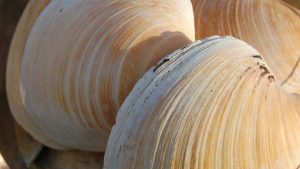
A study of the longest-living animal on Earth, the quahog clam, has provided researchers with an unprecedented insight into the history of the oceans.
By studying the chemistry of growth rings in the shells of the quahog clam, an international team led by experts from Cardiff University and Bangor University have pieced together the history of the North Atlantic Ocean over the past 1000 years and discovered how its role in driving the atmospheric climate has drastically changed.
The research team showed that prior to the industrial period (pre AD 1800), changes in the North Atlantic Ocean, brought about by variations in the Sun’s activity and volcanic eruptions, were driving our climate and led to changes in the atmosphere, which subsequently impacted our weather.
However, this has switched during the industrial period (1800-2000) and changes in the North Atlantic are now synchronous with, or lag behind, changes in the atmosphere, which the researchers believe could be due to the influences of greenhouse gases.
The results are extremely important in terms of discerning how changes in the North Atlantic Ocean may impact the climate and the weather across the Northern Hemisphere in the future.
The findings have been published in the journal Nature Communications.
The quahog clam, also known as a hard clam or chowder clam, is an edible mollusc native to the continental shelf seas of North America and Europe that can live for over 500 years.
The chemistry in the growth rings in the shells of the clam — which occur much like the annual growth rings in the centre of trees — can act as a proxy for the chemical make-up of the oceans, enabling researchers to reconstruct a history of how the oceans have changed over the past 1000 years with unprecedented dating precision.
By comparing this record with records of solar variability, volcanic eruptions and atmospheric air temperatures, the researchers have been able to construct a bigger picture and investigate how each of these things have been linked to one another over time.
Lead author of the study Dr David Reynolds, from the School of Earth and Ocean Sciences, said: “Our results show that solar variability and volcanic eruptions play a significant role in driving variability in the oceans over the past 1000 years. Results also showed that marine variability has played an active role in driving changes to Northern Hemisphere air temperatures in the pre-industrial era.
“This trend is not seen during the industrial period, where Northern Hemisphere temperature changes, driven by humanmade forcings, precede variability in the marine environment.”
Up until now, instrumental observations of the oceans have only spanned the last 100 years or so, whilst reconstructions using marine sediment cores come with significant age uncertainties. This has limited the ability of researchers to look further back in time and examine the role the ocean plays in the wider climate system using such detailed statistical analyses.
Co-author of the study Professor Ian Hall, from the School of Earth and Ocean Sciences, said: “Our results highlight the challenge of basing our understanding of the climate system on generally short observational records.
“Whilst they likely capture an element of natural variability, the strong anthropogenic trends observed over recent decades likely masks the true natural rhythms of the climate system. These data therefore provides an invaluable archive of the natural state of the ocean system and the expression of anthropogenic change over the last 1000 years.
“If we are to continue to develop the most robust near-term predictions of future climate change we must continue to develop robust reconstructions of past ocean variability.”
Reference:
D. J. Reynolds, J. D. Scourse, P. R. Halloran, A. J. Nederbragt, A. D. Wanamaker, P. G. Butler, C. A. Richardson, J. Heinemeier, J. Eiríksson, K. L. Knudsen, I. R. Hall. Annually resolved North Atlantic marine climate over the last millennium. Nature Communications, 2016; 7: 13502 DOI: 10.1038/ncomms13502
Note: The above post is reprinted from materials provided by Cardiff University.










